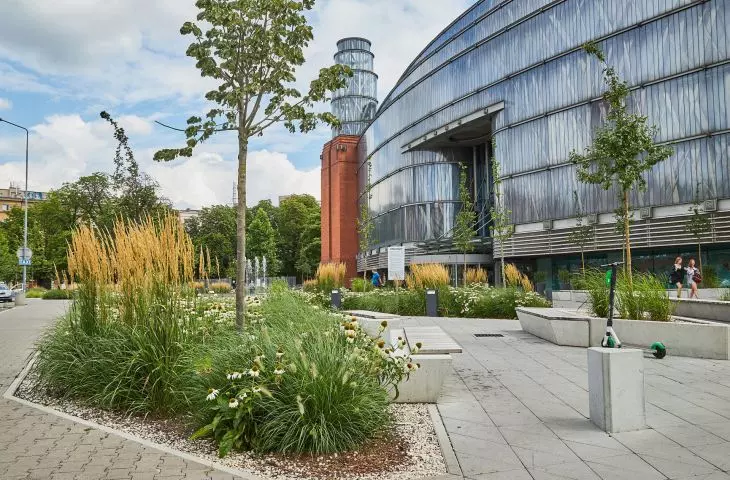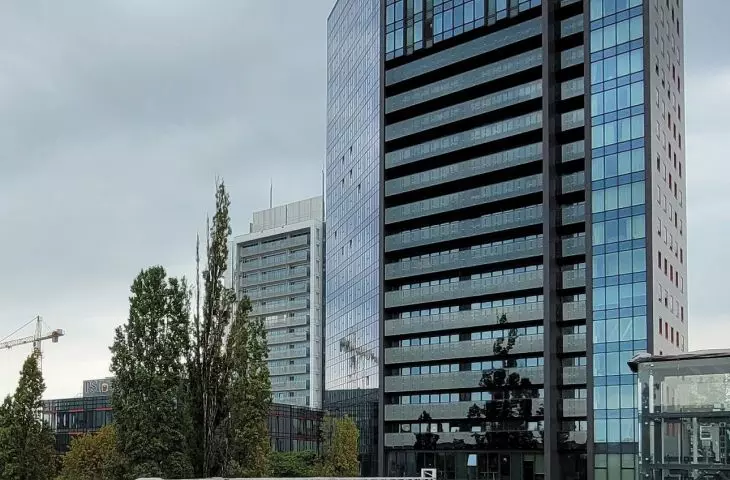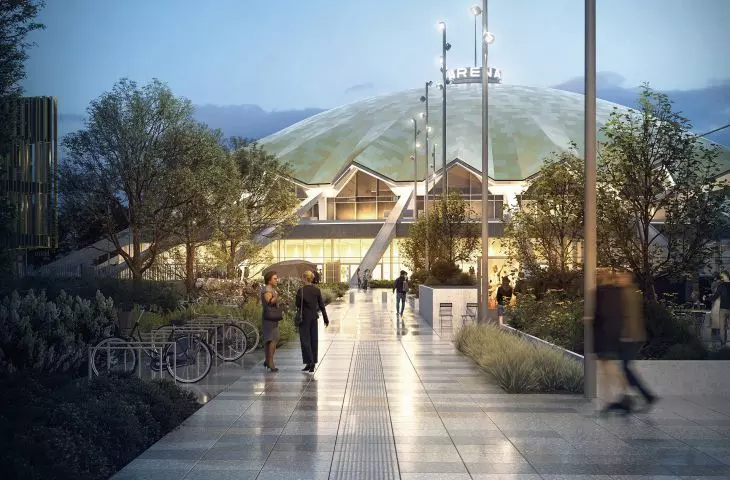Article taken from A&B issue 02|23
It's been eight years that a new team has been ruling Poznań, with which Poznań residents had high hopes. But the city ruled by Jacek Jaskowiak has averagely coped with the correct shaping of space and architecture. For the predecessors of the current authorities, the nail in the coffin turned out to be the construction of a new non-functional train station, the development of its surroundings and the inept reconstruction of the Kaponiera traffic circle. Today, other investments and the level of dialogue with residents are causing dissatisfaction.
At the end of 2014, after sixteen years, Ryszard Grobelny was replaced as mayor by Jacek Jaskowiak. Today, eight years after that election, the quality of management of spatial affairs and the style of governance resemble the climate of the decline of the era of his predecessors, even though the approach to shaping the city is more sensible. Instead, the common denominators are poor coordination, insufficient quality and growing arrogance. In 2015, there was little indication that things would turn out this way.
A greenbelt with new trees on the corner of Małeckiego and Kanałowa streets was created instead of parking spaces; similar solutions were introduced on other streets in the Lazarz, Jeżyce and Wilda districts, as well as in the city center
photo: Jakub Glaz
There were high hopes for Jaskowiak and his team at the time, although it was immediately apparent that the new mayor should urgently supplement his knowledge of the city. He could have done so, and at the same time used his managerial experience to improve the functioning of the institutions responsible for the city's development, and base its management on real social dialogue. However, this has not happened. In need of deep restructuring, the City Hall continues to this day in an ineffective form, with siloed management of decernates, poor coordination of activities and a very clumsy information policy. For the shaping of space, architecture and greenery, this is a toxic mix.
The balance sheet of the last eight years is therefore not negative, but bitter, because the potential and trust available to the new authorities was only partially used. The significant pluses of the first years of government (or the postponed derivatives of decisions made at the time) increasingly pale in the face of new shortcomings or omissions. Suffice it to mention the landscape resolution that has been in the pipeline for six years, which was supposed to be ready and worked out in the smallest details by 2019 at the latest. Meanwhile, the vote on it is scheduled for the end of January this year. It is also unclear whether councilors will say „yes” to the document, around which controversy has grown over the possible favoritism of selected outdoor companies. The resolution is gone, the city loses, and the advertising industry benefits all the time.
Kolegiacki Square, after reconstruction, was given back primarily to pedestrians; until 2017, a large part of it was occupied by a parking lot; the design by Krzysztof Urbaniak's Urbantech studio was selected in a 2016 competition, the work was completed a year ago
Photo: Jakub Głaz
An effective „hunt” for illegal advertising media (for which the city does not collect the fees due to it), is instead handled by social activist Tomasz Hejna. To say that he is disliked at City Hall is not enough. The same, by the way, is true of a whole host of other community activists, associations or experts, whom Jaskowiak has been treating as troublemakers for several years and likes to pit against „specialists,” but only those who support the magistrate's position. This is a rather amusing arrogance, because it was the socialists from the My Poznaniacy association who „invented” the entrepreneur Jaśkowiak as a candidate for mayor in 2010. He lost then. He owes his victory to his run for the Civic Platform four years later (and the withering of Grobelny's presidency). So if community activists and associations have bad ideas, is it also among them to drag Jaskowiak into city politics?
When it comes to spatial issues, the dispute between the magistrate and the social side is most often over greenery, public space and developer investments. In recent years, public awareness of the importance of nature in the city and climate change has evolved strongly. It seems that some decision-makers have not kept up with this. Some, because in matters of greenery it is possible to feel a lot of dissonance related, among other things, to the fact that far too many individuals are responsible for greenery and nature issues. Meanwhile, the authorities have been defending themselves for years against the appointment of a city naturalist (or at least—a horticulturist) who would coordinate inconsistent activities.
A fragment of the Łazarski market after reconstruction (designed by APA Jacek Bułat, implementation: 2021), view from under the market in the direction of Glogowska street—in the foreground a green area added to the project already during construction works; there are at least two more similar places on the square, which should be „unpaved” and greened
Photo: Jakub Głaz
A similar (and, of course, more significant) lack is felt at the head of all units responsible for space and architecture. It's true that Piotr Sobczak, director of the Department of Urban Planning and Architecture, is officially called the city's architect, but—like most of his predecessors—he lacks both the vision and the authority granted by the office to creatively watch over the long-term development of Poznań. And, very importantly, to comprehensively coordinate all the components of the city's puzzle: urban planning, transportation, architecture, aesthetics and environmental issues. He was also not selected in a competition, as were several other directors responsible for greenery or revitalization, for example.
However, let's stop at greenery. A major achievement here, for example, is the increasingly developed campaigns to „decongest” the streets of the city's historic districts, combined with the planting of trees, low greenery, traffic calming and civilizing parking. A success story, despite minor shortcomings, is the huge Rataje park completed in 2018, the construction of which was fought for by socialists while Grobelny was still president.
On the plus side, there are also other new parks, pocket squares and—invariably, for years—the development of street green belts, which are taken care of by the very creative Greenery Department of the City Roads Administration. Also encouraging is the change in thinking about „elegant” park greenery, as evidenced by the „decay areas” introduced last year, where fallen or felled trees decompose on lawns arranged in heaps. There is also a growing awareness of small-scale retention.
The office building of the Nowy Rynek complex on the corner of Wierzbięcice Street (designed by Medusa Group, realization: 2021)—on the right, earlier office buildings (designed by Maćków Pracownia Projektowa, realization: 2019); the empty space on the right is currently being developed with the tallest building of the complex by JEMS Architekci
photo: Przemyslaw Turlej
On the other hand, residents and activists are forced from time to time to intervene in defense of trees threatened with felling during city investments, or to demand more greenery from road engineers (also from ZDM) rebuilding streets or traffic circles (Wierzbięcice Street or the Rataje traffic circle). Also surprising was the favorable stance of the authorities on developer plans to develop the historic fort in Marcelina, combined with the cutting down of a large number of trees (the matter is pending, for now the investment has been halted).
On the other hand, the strongest protests have been raised against the insufficient amount of greenery during the numerous recent reconstructions of squares and the comprehensive revalorization of the streets of the inner city as part of the Projekt Centrum program, which has been implemented since 2017. Here, however, it should be noted that both the reconstruction of Lazarski Square and Kolegiac Square, as well as the entire Project Centrum (with Święty Marcin Street at the forefront) are the results of competitions eagerly organized by the current authorities, often in a new and effective „Flemish” formula divided into two stages. The previous team had no heart for competitions.
The square in front of the entrance to the Stary Browar shopping center on Ratajczaka Street; the paved and unfriendly space was replaced by a green-saturated realization by 1050 Architecture Studio (2020)
photo: © GARTE
So why the reservations and frequent complaints about „concretization"? It's the result of a change in residents' outlook on how public space should look, with a stiffening attitude by the City, some designers or the Office of the City Historic Preservation Officer. They have the same approach to shaping the city's "living rooms” as they did in the middle of the previous decade—when competitions were held. The awarded solutions are often treated almost as final, although in each case the jury provided a list of post-competition recommendations, sometimes with an indication of further public consultation.
If the recommendations had been fulfilled (which should have been ensured by the investor, i.e. the city), there would have been far fewer controversies, and the commissioned spaces would have looked better. This does not mean, however, that they are unsuccessful. On the contrary, the quality of the transformed spaces has increased significantly, but—without great efforts—it could have been even better. In the case of Lazarski Market, it was even possible to develop an additional green field with trees already during the works. More such spotty measures (belatedly, but always) need to be made to the reconstructed squares and streets.
Another problem is the protractedness of the renovations in the center and their extraordinary accumulation (the Old Market is now also undergoing a general revaluation), as well as the poor organization of the work and the communication of changes and intentions, which weakens from year to year. The culprits here are, in part, the pandemic, as well as the war in Ukraine (which the authorities like to repeat relentlessly) and the need to spend EU money by the end of this year. However, there is also a great failure of coordination and public hearing in the „producers” of magistrate communiqués that sometimes verge on simplistic propaganda of success. They sound particularly sad in a situation where pandemonium, inflation and chronic renovations are doing the work of destroying downtown commerce and services. A destruction initiated by the construction of redundant shopping centers located too close to the center (these decisions are the fault of the previous team).
Poznań's tallest residential skyscraper stands right next to the Central Railway Station (corner of Składowa and Matya streets; address: Towarowa 39)—measuring 73 meters in height, the building was designed by Ewa and Stanisław Sipiński Architectural Studio (view from the west from Dworcowy Bridge; completion: 2021)
photo: Jakub Głaz
Against this background, private investors have been pleasantly surprising lately. A successful and friendly green square was given to Poznań residents by the owner of Stary Browar in place of the previously paved dead field in front of the entrance from Ratajczaka Street (designed by 1050 Pracownia Architektury, 2020). On the other hand, in December, luscious trees were planted in the so-called New Market, the central square of the office complex under construction in the place of the former bus station (Ultra Architects is responsible for the design of the square and common spaces). The complex of these quite successful buildings designed by different studios (JEMS Architects, Medusa Group, Maćków Pracownia Projektowa) is a well-thought-out concept resulting from a 2016 investor competition. It's just a pity that instead of the previously planned residential buildings, the final phase will also include an office building, thus creating a functional monoculture.











































